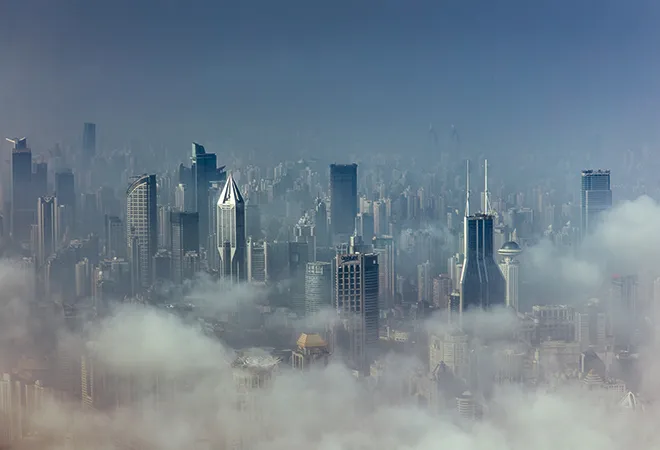
2020 was a challenging year like none other, bringing the entire planet to a pause. Although the outbreak of the COVID-19 disease leading to the global pandemic was the centre of international attention, nevertheless, the world also witnessed
many significant incidents last year with reference to global warming. 2020 has become the second warmest year, with record-high key greenhouse gases concentrations in the atmosphere and evidently high surface temperatures. Climate-related weather disasters, in particular, cyclones and vast wildfires were seen in unprecedented numbers. The year was a highly unstable and tumultuous one on the geopolitical front too across the globe. China, in particular, marked an eventful 2020, adopting an aggressive posture with assertions along India’s border, a trade war with Australia, imposing new security laws for Hong Kong and also intruded into Taiwanese airspace, besides its continuous tussle with the West, on top of spreading the novel coronavirus.
Despite all the above-mentioned activities, China exhibited some proactive positivity, especially in the domain of climate action.
Chinese President Xi Jinping’s pledge about China reaching the peak of carbon-dioxide emissions by 2030, and thereafter, cutting the net greenhouse gas emissions to zero to achieve carbon neutrality by 2060 at the United Nations General Assembly in September 2020 has left the whole world startled. Additionally, the Ministry of Foreign Affairs of China along with the Tibetan regional government organised a
virtual seminar on ‘Ecological Environment Protection’ under the aegis of the Trans-Himalaya Forum for International Cooperation in February 2021. The event witnessed participation from former United Nations Secretary-General Ban Ki-moon and former Australian Prime Minister Kevin Rudd, along with countries in Asia, Europe, the United States (US), and Latin America.
Environmental degradation and climate crisis constitute one amongst the primary challenges for the Chinese Communist Party (CCP), which is observing its hundredth anniversary in 2021. In spite of China being in the lead for global warming with approximately 30 percent of overall world-wide emissions, environmental protocols have been habitually
forfeited by the CCP once economic growth and GDP goals are vulnerable. Therefore, weakening industrial and trade activities in the country result in rising pollution, albeit ironically. With increasing public awareness leading to more petitions and protests on the issue, the solitary ruling political party in China has rather demonstrated more resolve to quell dissent.
Environmental degradation and climate crisis constitute one amongst the primary challenges for the Chinese Communist Party (CCP), which is observing its hundredth anniversary in 2021. In spite of China being in the lead for global warming with approximately 30 percent of overall world-wide emissions, environmental protocols have been habitually forfeited by the CCP once economic growth and GDP goals are vulnerable
Going by
the 2020 figures regarding coal, around 56.8 percent of China’s total energy consumption was made up of thermal coal, which still is extensively used for power generation; approximately 3.84 billion tonnes of coal was produced (highest since 2015); consumption of coal grew about 0.6 percent (which is the fourth consecutive increase); besides China imported nearly 304 million tonnes of coal, which is almost 4 million tonnes higher than last year. Even with strict lockdowns in the early months of 2020 that closed most industries, coal consumption in China was around
4.04 billion tonnes. Taking
the emissions data into account, China’s carbon dioxide (CO
2) emissions rose roughly 4 percent in the latter half of 2020, although the early half saw emissions drop by approximately 3 percent because of the pandemic-induced lockdowns. However, the total CO
2 emissions in China increased by 1.5 percent in comparison to 2019 figures. In connection with the CO
2 emissions,
air pollution in China overpassed the pre-pandemic levels since mid-April in 2020, with industrial activities gearing up for bringing the economy back on track. In fact, air pollution decreased dramatically in March 2020, and during the peak lockdown period, concentration levels of some greenhouse gases had plunged by almost 40 percent.China sets out to achieve carbon neutrality
While the details of the plan to achieve carbon neutrality by 2060 have not been disclosed, being the largest producer and consumer of coal, and also the hugest emitter of greenhouse gases in the world, the targets promised by President Xi look quite ambitious for China, and there is a need to analyse the vow meticulously. Starting from the late 1990s, climate change issues have ascended the agenda of China’s policy priorities, and the headship has steadily introduced more elaborate and aspiring climate policies over the recent years. This is evident in documents such as the five-year plans and also the Intended Nationally Determined Contributions that China presented prior to the historic Paris Climate Change Conference in 2015. Moreover, China has focused on
actions, laws, and policies to lessen dependence on coal and its consumption and utilise renewable energy and have yielded positive results. Some of these are—Air Pollution Action Plan, National Emissions Trading Scheme, Made in China 2025, Renewable Energy Law, Clean Energy Consumption Action Plan, Energy Development Strategy Action Plan, etc. Furthermore, China has surfaced as a world leader in renewable energy, specifically solar and wind. As per the
National Energy Administration (NEA) statistics, almost 71.67 gigawatts (GW) of wind power capacity was added and new solar power capacity picked up to 48.2 GW—thereby, doubling China’s new renewable capacity in 2020. Additionally, China heads in electric vehicles use and battery production. While waiting for other clean energy sources to be obtainable, natural gas, considered as a bridge fuel, is being increasingly opted. Along with these, renewed thrust is being given to the development of nuclear power as an alternative to fossil fuels and limit carbon emissions, with the aspiration to have
70 GW of generation capacity by 2025.
Leading the climate-conscious world
Meanwhile, with President Joe Biden formally taking up the baton as the new American president, the US is bucking up to be back to the global climate community. Combatting climate change has had been one of the most important targets planned as part of Biden’s agenda since his campaigning days. Soon after assuming office, as promised, in February 2021 the
US officially re-joined the Paris climate accord, after four years of absenteeism. The US now needs to slog hard to bridge the inactivity hiatus by making ambitious yet achievable commitments, and assisting other countries to do the same.
China has indicated that climate leadership is a key priority regardless of other countries’ moves, including the US. Towards that President Xi has consciously opted for segregating the Chinese approach from the conventional Western principles of liberal environmentalism
China has indicated that climate leadership is a key priority regardless of other countries’ moves, including the US. Towards that President Xi has consciously opted for segregating the Chinese approach from the conventional Western principles of liberal environmentalism. In 2007, President Hu Jintao had originally applied the term
“ecological civilisation” while illustrating China’s own style of environmentalism; and as a continuation, President Xi has incorporated it into the CCP’s lexicon and made it a vital support for his country’s advancement. On the global platform, China had been always advocating for ‘Common but Differentiated Responsibilities and Respective Capabilities (CBDR–RC)’—a guiding principle in international climate change negotiations, claiming that as a developing country, it should not be compelled to reduce emissions as compared to the developed and industrialised countries whose emissions went unhindered for decades. With its leader’s landmark announcement, the world’s second-largest economy has indicated an overdue departure from its earlier position on CBDR-RC and is now vowing to steer the way, setting itself aims appropriate for a country aspiring to be a superpower. In fact, net-zero by 2050 pledges came from Japan and Korea soon after China’s announcement, shortly to be followed by the US, and in total around 124 nations have made
net-zero pledges before the upcoming international climate summit in Glasgow in November. What Beijing needs to be indeed cautious about is its support to sizeable amounts of carbon-intensive infrastructure around the world, including coal-fired power stations under its ambitious
Belt and Road Initiative, and ensure that it does not become a destination to dump China’s brown industries.
Climate change has been accepted as a reality and all countries across the globe have agreed to tackle it now. As pointed out by many, meaningful global action could not progress without major commitments from China, which now stands at the centre of the new geopolitics of climate change, especially after the US dormancy period. As a matter of fact, climate change is one issue that provides a grand prospect for China and other world powers to cooperate and not compete and reset their relationships. It is essential for countries to urgently work on the environmental domain as Asian countries, and in particular, China and India are at risk because of the natural disasters resulting from climate change. Committing to act more on the climate change front is an opportune moment and might at least counterbalance the escalating resentment against China for all its wrongdoings and help to mend its international image and relations.
The views expressed above belong to the author(s). ORF research and analyses now available on Telegram! Click here to access our curated content — blogs, longforms and interviews.



 2020 was a challenging year like none other, bringing the entire planet to a pause. Although the outbreak of the COVID-19 disease leading to the global pandemic was the centre of international attention, nevertheless, the world also witnessed
2020 was a challenging year like none other, bringing the entire planet to a pause. Although the outbreak of the COVID-19 disease leading to the global pandemic was the centre of international attention, nevertheless, the world also witnessed  PREV
PREV


